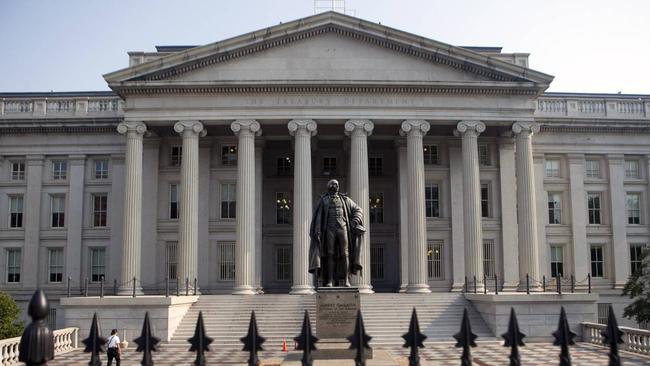The canaries in the bond coal mine are warning of rising debt risks
Bond market specialists have pointed to a worrying spike in the indicators that presaged the last financial crisis.

The "TED spread" — the difference between the three-month London Interbank Offered Rate (LIBOR) and the yield on three-month US Treasuries — has nearly doubled in the past month, from 22 basis points to 40 basis. The spread between LIBOR and the Overnight Index Swap rate (OIS) has reached levels approaching 50 basis points, a gap not seen since 2012.
The TED spread is regarded as an indicator of the level of credit risk within the global economy while the LIBOR-OIS spread is seen as a gauge of the perceived risk within the banking system.
While they started widening in 2007, both spreads blew out dramatically in 2008 as the financial crisis erupted. The 2012 widening of the spreads was during a period of rising concerns about European sovereign debt. Generally, the spreads have proven a strong lead indicator of periods of systemic stress like the 1987 sharemarket crash, the Asian financial crisis and the "tech wreck" in 2000.
That’s why they are again attracting interest among bond market analysts. This time, however, the influences behind their widening might be somewhat different and perhaps somewhat longer term.
The most obvious is that US interest rates are on the move, and will probably rise again after next week’s meeting of the US Federal Reserve Board’s open market committee meeting. The US yield curve is shifting up and, after showing signs of steepening early this year, has flattened recently as short term rates have spiked.
There are two reasons that have been proffered for why that should be so, and how that feeds into the TED spread and LIBOR-OIS trends. They are both peculiar to the US.
The first is the Trump administration’s tax cuts, which are estimated to add about $US1 trillion, if not more, to US Government debt over the next decade. Those cuts are being funded by an increase in the US deficit and will result in an increase in the issuance of US Treasury bonds.
That, and another factor, is expected to see the US Treasury raise almost $US1 trillion in new issuance of bonds this year, much of it in short-dated securities. That’s nearly twice its issuance last year.
The other factor is the progressive and accelerating shrinking of the Fed’s balance sheet, which will have $US425 billion of maturing bonds this year but reinvest only $US195bn. As the Fed’s purchases of bonds were direct, that means other investors will have to be tapped to fill the $US230bn of demand previously provided by the Fed.
At the same time as the supply of US Government debt is surging and the Fed’s appetite for it is diminishing, another element of the Trump tax package is having an impact.
US multinationals, potentially the giant tech companies, have stashed trillions of dollars of cash offshore rather than face having to pay the US corporate tax rate on repatriated funds. Under the Trump tax package, there is a lower rate and a tax incentive to shift those funds to the US and a potential penalty if they remain held offshore.
Those funds are generally held in US dollar securities and there is one theory that they are being shifted into cash in preparation for their repatriation. A diminution in demand for Treasuries from that source would have an impact on US rates.
There is a flow through effect into the wider financial sector from a widening of the TED and LIBOR-OIS spread.
Rather than reflecting an increase in caution about overnight lending to other banks, or a perceived rise in credit risk, it may well reflect something of a structural change as the Fed steadily withdraws the massive doses of liquidity it pumped into the system post-crisis, when its balance sheet grew by $US3.6 trillion, and the US Government’s deficits and debt (estimated to hit $US30 trillion within a decade) blow out.
That will flow through to higher funding costs for banks and their customers and with the US Treasury program, focused in the near turn at the short end of the maturity spectrum, a particular increase in short term rates. That’s at a point where the US economy is already operating at or near capacity and there are signs of inflation re-emerging in the US.
The longer term concern — and perhaps the signal that the spreads are providing — is the sheer level of debt within the US and the global financial system more generally.
US Government debt has roughly doubled since the financial crisis and is running at more than 100 per cent of US. Ultra-low interest rates since the crisis has also seen corporate and household debt explode. The global debt-to-GDP ratio is estimated at nearly 320 per cent, with total debt rising by about $US90 trillion, to more than $US230 trillion, since 2007.
A concern would be that the circumstances developing in the US and the likelihood, if not later this year then next year, that the European Central Bank will start winding down its asset-purchasing program could lead to an abrupt and significant surge in market rates.
For economies that have for a decade being gorging on ultra-low rates and are now quite highly leveraged, a tightening of credit market liquidity and a spike in interest costs could be quite stressful.
The TED and LIBOR-OIS spreads are often described as the canaries in the coal mine for credit markets.
The recent widening of the spreads may be just hiccups as the markets digest a confluence of unusual circumstances. It’s conceivable, however, that they are the first indicators that the birds are warming up for what might develop in the longer term into a full-throated song.






Just in the past week, the interest of bond market specialists has been piqued by the spiking of the indicators that presaged the financial crisis.